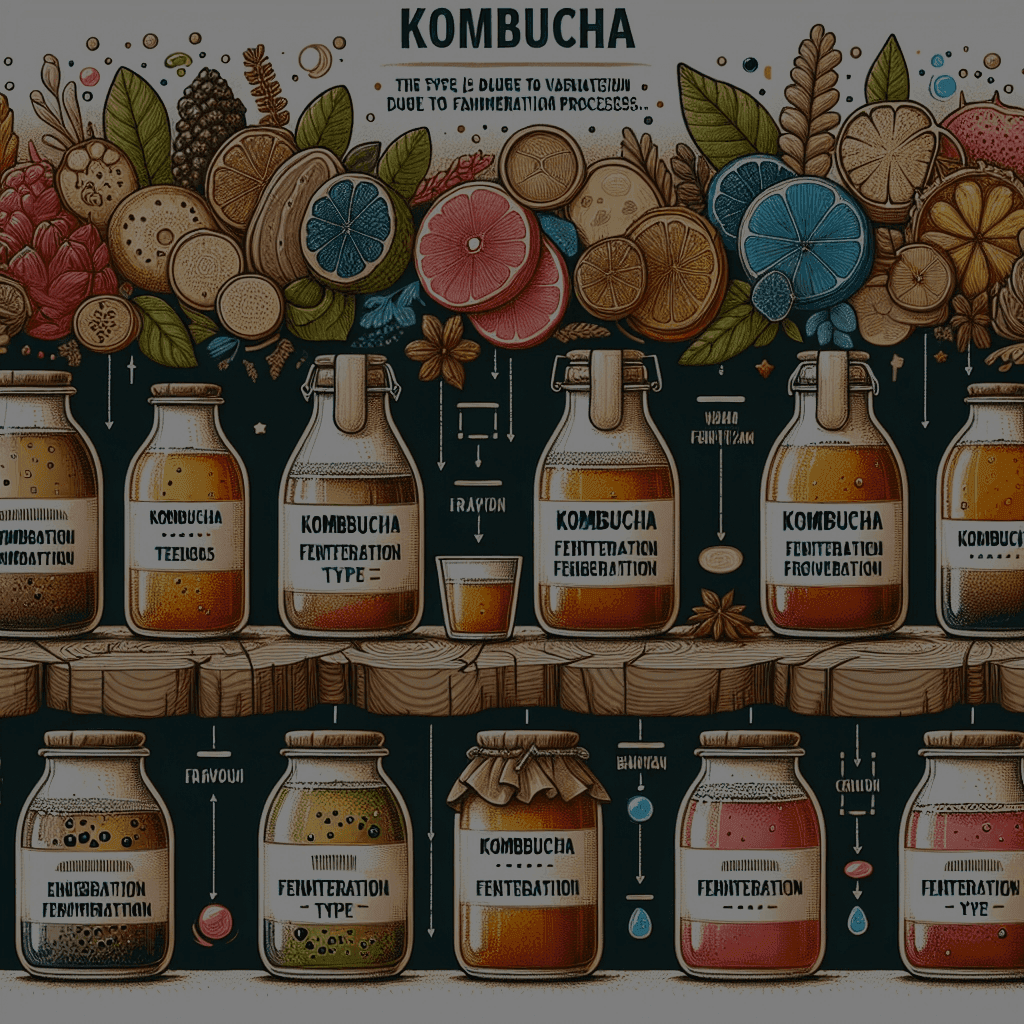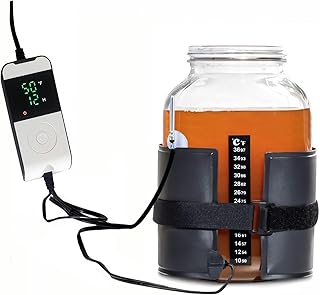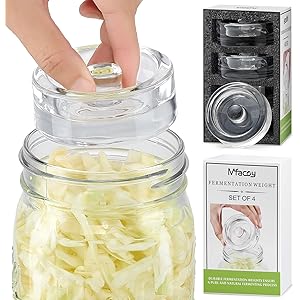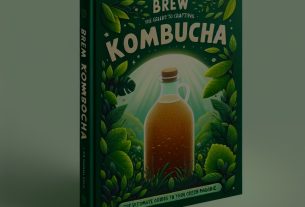Kombucha: Understanding the Types of Fermentation and Their Impact on Flavor
Kombucha, the effervescent drink made through fermentation, has gained immense popularity in recent years. Known for its unique flavors and potential health benefits, this fermented tea is not just a refreshing beverage but also a product of a fascinating fermentation process. In this comprehensive guide, we will explore the types of fermentation involved in kombucha production, how they affect flavor and health benefits, and tips for brewing your own delicious kombucha at home.
What is Kombucha?
Kombucha is a fermented beverage made from sweetened tea and a symbiotic culture of bacteria and yeast, commonly referred to as SCOBY (Symbiotic Culture of Bacteria and Yeast). This process transforms the sugar in the tea into organic acids, gases, and various beneficial compounds, resulting in a tangy, effervescent drink that is both delicious and purportedly healthful.
The Fermentation Process
Kombucha undergoes two primary stages of fermentation:
- Primary Fermentation: This is where the bulk of the fermentation occurs, typically lasting 7 to 14 days.
- Secondary Fermentation: In this stage, flavoring and carbonation are developed, usually lasting an additional 3 to 7 days.
Let’s dive deeper into these stages to understand the fermentation process better.
Primary Fermentation
The Role of the SCOBY
The SCOBY is crucial in the primary fermentation stage. It contains a variety of yeast and bacteria that work together to ferment the sweetened tea. The yeast consumes the sugar and converts it into alcohol and carbon dioxide, while the bacteria convert the alcohol into acetic acid, which gives kombucha its characteristic tangy flavor.
Environmental Factors
The success of primary fermentation is influenced by several environmental factors, including:
- Temperature: Ideally, kombucha ferments best at temperatures between 70°F and 85°F (21°C to 29°C). Higher temperatures speed up fermentation, while lower temperatures can slow it down.
- pH Level: The initial pH of the sweetened tea should be around 5-6 to prevent harmful bacteria from proliferating.
- Oxygen Exposure: Kombucha requires oxygen during fermentation, so using a breathable cover like a cloth or coffee filter is essential.
Duration of Fermentation
The length of primary fermentation affects the flavor profile of kombucha:
- Short Fermentation (3-7 Days): Results in a sweeter kombucha, as less sugar has been converted into acids.
- Medium Fermentation (7-10 Days): Produces a balanced flavor, with a moderate level of sweetness and acidity.
- Long Fermentation (10-14 Days): Leads to a more tangy, vinegar-like taste, as the sugar is mostly converted into acetic acid.
Secondary Fermentation
After the primary fermentation, the kombucha can be bottled for secondary fermentation, during which flavors and carbonation develop. This stage is optional but can significantly enhance the taste and effervescence of the final product.
Flavoring Kombucha
During secondary fermentation, you can add various flavoring agents to enhance the kombucha’s taste. Common flavorings include:
- Fruits: Fresh or frozen fruits like berries, citrus, and stone fruits can add natural sweetness and flavors.
- Herbs: Fresh herbs like mint, basil, or thyme can provide unique flavor profiles.
- Spices: Ginger, cinnamon, and vanilla are popular spices that add warmth and depth to kombucha.
The Carbonation Process
Secondary fermentation allows natural carbonation to develop. As the yeast continues to ferment the residual sugars from the flavoring, carbon dioxide is produced, resulting in a fizzy drink.
Duration of Secondary Fermentation
The length of secondary fermentation affects carbonation levels:
- Short Secondary Fermentation (1-3 Days): Results in a lightly carbonated drink.
- Long Secondary Fermentation (3-7 Days): Leads to a more effervescent kombucha. However, it’s essential to monitor for pressure buildup to avoid exploding bottles.
Safety Considerations
While brewing kombucha, it’s crucial to ensure safe fermentation practices:
- Use Clean Equipment: Sanitize all equipment to prevent contamination.
- Monitor Pressure: If bottling for secondary fermentation, regularly check the pressure to prevent explosions.
- Taste Testing: Sample the kombucha during both fermentation stages to achieve the desired flavor.
Types of Fermentation in Kombucha
The fermentation process in kombucha can be classified into several types based on different factors, including the source of sugar, type of tea, and the specific microorganisms involved. Let’s explore these types of fermentation.
1. Alcoholic Fermentation
Kombucha naturally contains low levels of alcohol due to the yeast’s fermentation of sugars. However, the alcohol content is usually below 0.5% ABV (alcohol by volume) if the fermentation process is controlled properly.
Impact on Flavor
Alcoholic fermentation can contribute to the complexity of flavor, enhancing the drink’s overall profile. However, excessive fermentation can lead to higher alcohol content, which may not be desirable for all consumers.
2. Acetic Acid Fermentation
Acetic acid fermentation occurs when bacteria in the SCOBY convert the alcohol produced during fermentation into acetic acid. This process is responsible for kombucha’s signature tangy flavor.
Impact on Flavor
The level of acetic acid in kombucha determines its sourness. A well-balanced kombucha should have a pleasant tartness without being overpowering.
3. Lactic Acid Fermentation
Although not as pronounced in traditional kombucha, lactic acid fermentation can occur if specific lactic acid bacteria are present. This type of fermentation is more common in other fermented foods like yogurt and sauerkraut.
Impact on Flavor
Lactic acid fermentation imparts a mild tang and creaminess to the drink. Some kombucha brewers intentionally introduce these bacteria to create a unique flavor profile.
4. Carbonic Acid Fermentation
During the secondary fermentation process, carbonic acid is produced from the fermentation of sugars in flavorings. This is what gives kombucha its characteristic fizziness.
Impact on Flavor
Carbonic acid contributes to the refreshing mouthfeel and overall drinking experience of kombucha.
Health Benefits of Fermented Kombucha
Kombucha is not just a flavorful beverage; it is also associated with various health benefits due to its unique fermentation process. Here are some of the potential health advantages of consuming kombucha:
- Probiotics for Gut Health: The live cultures in kombucha can promote a healthy gut microbiome, aiding digestion and potentially improving overall gut health.
- Rich in Antioxidants: Kombucha made from green tea contains antioxidants, which help combat oxidative stress and inflammation in the body.
- Detoxification: The acetic acid produced during fermentation may assist in liver detoxification by promoting the elimination of toxins.
- Immune Support: The probiotics and organic acids in kombucha may enhance the immune system and help the body fight off infections.
- Energy Boost: Some individuals report increased energy levels after consuming kombucha, likely due to the presence of B vitamins and organic acids.
- Potential Weight Management: Kombucha is a low-calorie beverage that can serve as a healthier alternative to sugary sodas and juices, potentially aiding in weight management.
How to Brew Kombucha at Home
Now that you understand the types of fermentation involved in kombucha production, you might be eager to try brewing your own. Here’s a simple step-by-step guide to get you started:
Ingredients
- 1 cup granulated sugar
- 8 tea bags (black or green tea)
- 1 SCOBY
- 1-2 cups starter tea (from a previous batch or store-bought)
- 1 gallon of filtered water
Equipment
- 1-gallon glass jar
- Cloth cover (coffee filter or cheesecloth)
- Rubber band
- Wooden or plastic spoon
- Glass bottles for storage
Brewing Steps
- Brew the Tea: Boil 4 cups of water, steep the tea bags for 10-15 minutes, and dissolve the sugar in the hot tea. Add 4 cups of cool water to bring it to room temperature.
- Combine Ingredients: Pour the sweetened tea into the glass jar, add the starter tea, and gently introduce the SCOBY.
- Cover and Ferment: Cover the jar with the cloth and secure it with a rubber band. Place it in a warm, dark area and allow it to ferment for 7-14 days.
- Taste Test: After about a week, taste the kombucha. If it’s too sweet, let it ferment longer; if it’s too sour, reduce fermentation time in future batches.
- Bottle the Kombucha: Once you reach your desired flavor, remove the SCOBY, and reserve 1 cup of kombucha as starter tea for your next batch. Pour the finished kombucha into bottles, leaving some headspace for carbonation.
- Secondary Fermentation (Optional): Add flavorings if desired, cap the bottles, and let them sit at room temperature for 3-7 days for carbonation. Refrigerate once the desired fizz is achieved.
Troubleshooting Tips
- Too Sweet: Let it ferment longer.
- Too Sour: Reduce fermentation time next time.
- Flat: Ensure airtight seals and allow for more fermentation.
Kombucha is a fascinating beverage with a rich history and a complex fermentation process. Understanding the types of fermentation involved can enhance your brewing experience and help you create delicious, health-promoting kombucha at home. By experimenting with flavors, fermentation times, and techniques, you can craft a kombucha that perfectly suits your taste preferences.
Whether you’re a kombucha enthusiast or just starting your brewing journey, this guide serves as a comprehensive resource to help you navigate the world of kombucha fermentation. Enjoy the journey of creating your own unique flavors and savor the refreshing taste of homemade kombucha. Cheers to your health and happiness!
MFacoy 4-Pack of Fermentation Glass Weights with Easy Grip Handle for Great Wide Mouth Canning Mason Jars, Pickling Sourkrout Kraut Glass Weight Fermentation Kit with Easy Grip Handle, Dishwasher Safe
$11.99 (as of 23/10/2025 13:07 GMT -03:00 - More infoProduct prices and availability are accurate as of the date/time indicated and are subject to change. Any price and availability information displayed on [relevant Amazon Site(s), as applicable] at the time of purchase will apply to the purchase of this product.)
Receive tips, news and exclusive offers! Sign up for our newsletter now!










